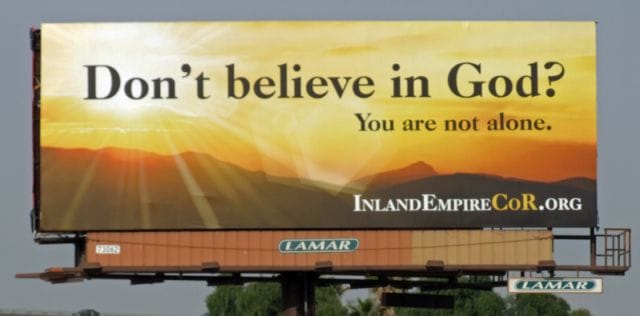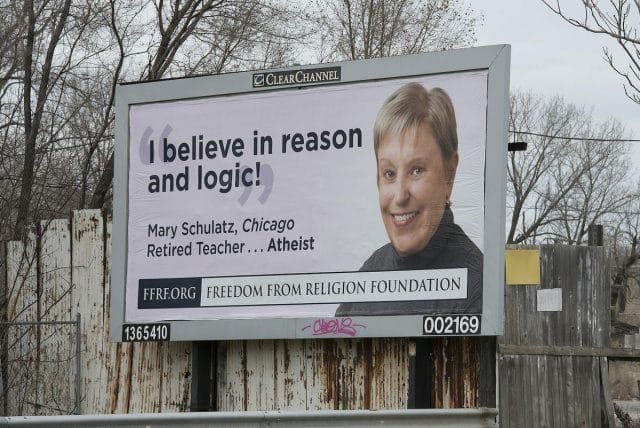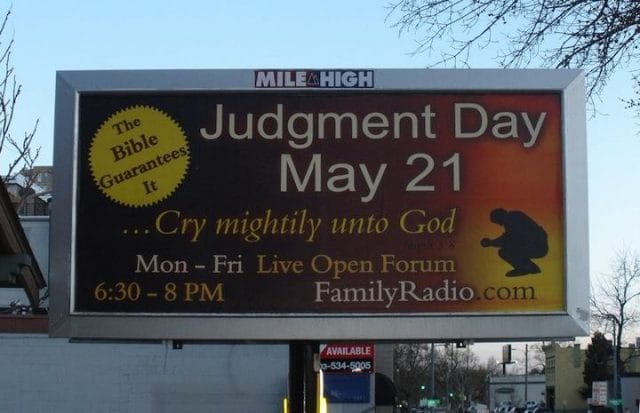
Image source: Chuck Coker on Flickr.
Despite advertising agencies’ best efforts, billboards are rarely memorable. Images of happy, young models drinking Coke blur into images of happy, young models drinking Budweiser. Bright colors don’t stand out when everyone uses bright colors. Even copywriters’ best puns rarely catch drivers’ attention.
Yet in this author’s experience, there has always been an exception: Billboards of fiery crosses that say “REPENT!” Billboards that ask “Where are you going? Heaven or Hell?” Billboards depicting Jesus, that read “He died for your sins.”
Religious billboards stand out, and they have left this non-religious author wondering whether they are meant as antagonistic messages to nonbelievers, or are somewhat misguided recruiting efforts.
It turns out that, according to the people who erect these signs, the billboards’ target audience is the already converted. They appear most meaningful to religious people facing tough times, and they are a symbol of community for the rest. And we may see a lot more religious billboards in the future.
Religious Billboards: A Local Affair
Answers in Genesis is a “Christianity-defending ministry” with a $20 million budget focused on exposing “the bankruptcy of evolutionary ideas.” Its Creation Museum in Kentucky, which depicts humans living alongside dinosaurs, employs 300 people, and the organization is building a $29.5 million Noah’s Ark theme park.
Its CEO champions “marketing” Christian messages. Answers in Genesis pays Joseph David Advertising over $900,000 a year (as of 2013) to design its billboard and television ad campaigns. Over New Year’s, it placed a video billboard featuring a cross and the words “Thank God for Freedom” in Times Square. Joseph David Advertising says a billboard campaign it ran for the Creation Museum was nominated for an OBIE award for excellence in advertising.
Answers in Genesis is an outlier when it comes to religious billboards. Organizations like Billboards for Christ seem more typical of the humbler efforts behind most religious billboards. The group’s founder believes God sent a billboard designer to help her when she got a flat tire as a sign. With the help of several volunteers, she raises money on a primitive website and has around 30 billboards of Bible verses up at a time. Other small organizations focus on specific issues like faith-based opposition to abortion or evolution.
Jay Stoltzfus, the administrative assistant of Christian Aid Ministries’ Billboard Evangelism program, seems to agree that most religious billboards are local efforts. He says that Answers in Genesis is the only major organization he knows offhand that puts up billboards, although he knows many churches that organize local billboards.
Christian Aid Ministries is a major organization with billboards across America. Most of its budget funds charity, like food aid and disaster relief. The organization says funds for its billboards come mostly from fundraising at local churches. Similarly, the Knights of Columbus is a large Catholic benefit society. Its billboards are modest efforts by its local chapters. The billboards of both organizations are done without huge budgets or the work of glossy ad agencies. Christian Aid Ministries spent just under $1.7 million on billboards in 2013. The committees that develop the text are employees, and its public relations department designs the billboards.
In America, Christian billboards — as opposed to billboards for or promoting other religious beliefs — seem most common, although there is no database that can verify this fact. But other groups do organize billboards, and a small number of atheist billboard campaigns have garnered significant press.

Image Source: Coalition of Reason
The Freedom from Religion Foundation posts billboards with slogans like “Sleep in on Sundays” and quotes from atheists and humanists. (Famed psychologist Steven Pinker’s reads, “Morality comes from reason, not dogma.”) The Foundation’s billboards correspond to those of Answers in Genesis in terms of production value and tone. Most atheist billboards seem to resemble efforts like that of the local Riverside, California, chapter of the Coalition of Reason. The organization’s billboard, which reads, “Don’t believe in God? You are not alone,” is simply a tagline written over a stock photo taken from its umbrella organization.
Preaching to the Converted
American companies spend incredible amounts of time and money trying to measure if their advertisements work. Organizers of religious billboards can track whether more people visit their websites or attend their events. Yet as Jay Stoltzfus concedes about Christian Aid Ministries’ billboard evangelism, “We’ll probably never know how much our work has benefitted people. Maybe on the other side, God will show us.”
Unlike other religious billboards, however, those put up by Christian Aid Ministries have a phone hotline, 855-FOR-TRUTH, staffed 24/7 by pastors and volunteers. The result is an insight into who is most influenced by religious billboards.
Stoltzfus says the most common calls are supportive messages from fellow Christians. A few are from atheists and agnostics who mock the billboard and the organization. The most substantive calls, however, come from people who are struggling and look to religion for help with problems like drug addictions and broken marriages.
Johnny Miller worked for Christian Aid Ministries for 18 years, and as director of a Romanian orphanage for many of them. He spends his retirement as one of 13 volunteers who man the billboard hotline. Miller has three buttons he could push during a call to play recorded sermons, but he says he enjoys talking and connecting to people every day.
Over the phone, Miller tells us about a caller who said he was a Satanist because God let his mother murder his father. He tells us about a well-off woman addicted to heroine calling on Christmas day because she was contemplating suicide.
Miller hears a lot of stories like this. Christian Aid Ministries receives around 200 calls a day on its hotline, according to its figures. That’s roughly 1 in every 16,000 to 20,000 people who see the billboards, many of whom are shocked to hear a human voice rather than a recording. Miller believes these individuals need God; he also recommends professional health services in cases like the woman addicted to heroine.
Backers of religious billboards see them as evangelism. The founder of Billboards for Christ writes that the billboards are “ministering to those who would never enter a church, listen to a sermon, or keep on a station/channel where the Lord is exalted.” Miller similarly wants to both “introduce people to Jesus Christ as a savior from a sinful life” and “to help Christians live a Christ-like life.”
As the hotline calls demonstrate, the billboards seem to mostly do the latter. The billboards’ backers hope they will evangelize everyone, but as with most advertisements, the billboards are really for people predisposed to the message. Messages that seem oddly threatening to atheists and agnostics (“Heaven or Hell?”) are instead, to the right audience, a call to be true to their beliefs, an offer of help, or a sign of community.

Courtesy of the Freedom from Religion Foundation
The same is true of atheist billboards, whether they say “Sleep in on Sundays” or “You are not alone.” According to Rebecca Kitchings of the Inland Empire Coalition of Reason in Riverside, the idea behind the atheist billboard campaign “was to reach out in the community and let people know that atheists are there and there is a community.”
The New Town Square
Most religious billboards are modest efforts. They rely on crowdfunded donations and point to websites that look a decade old. Many organizations never have the benefit of speaking to a professional marketer.
So when organizations do devote themselves to putting up billboards, they face a learning curve. Johnny Miller says the first obstacle Christian Aid Ministries faced was that the church members donating to their billboard evangelism program wanted to put the billboards near their churches. “We had 19 billboards in Eastern Pennsylvania and not one in LA,” Miller says. “It took awhile to convince people we needed to put them where more people can see them and in areas that are less churched.”
Christian Aid Ministries also learned lessons familiar to digital journalists crafting headlines. “Questions do better than statements,” Miller says. “People feel a need to answer that question when they call us.” But as employees have tweaked the text on billboards to see which result in more calls, they have had to ask whether prioritizing the number of calls is the right approach. The message “In despair? Jesus is your hope” did not lead to many calls. But Miller says that the slogan drew callers facing more significant problems.
Billboards are a blunt advertising instrument, so we wondered if the organizers of religious billboards planned to advertise online, which can be more targeted and precise. Would it be better for Christian Aid Ministries to advertise on Facebook to people who enter “Christian” as their religion or to people who google words like “depression” or “hell”? Could the Coalition of Reason advertise more efficiently by targeting people who identify as atheist on Facebook? Or to people who Facebook knows are likely atheists based on their television preferences or because they once shared an article from an atheist newspaper?
When we ask Rebecca Kitchings of the Coalition of Reason, she says that their members do promote the group on Facebook and Twitter. She adds that purchasing ads on social networks is “on a list of things to look at,” but they struggle to do more due to a lack of paid staff.
Yet Kitchings indicates that billboards may trump targeted, online ads for their goals. Billboards are a blunt instrument, but they are public, prominent, and when placed in areas like Times Square, capture some of the prestige and cultural cachet that lead corporations to pay $4.5 million for a 30 second Super Bowl ad. The Coalition of Reason’s billboards resulted in a string of articles about “those atheist billboards,” and it’s hard to imagine targeted ads inciting the same reaction. Although the Inland Empire billboard’s main audience is fellow atheists, Kitchings describes the billboard as “a ‘hello, we’re here’ kind of announcement” to both atheists and non-atheists alike.

Okay then. Photo credit: Dave Riggs
For this reason, we may see a lot more billboards about religion in the future. In recent years, Christians have made up a smaller and smaller percentage of the US population, and America’s 56 million atheists and “religiously unaffiliated” are on the rise. Debates over religion and identity politics are ascendent. Many religious leaders and politicians responded to the legalization of gay marriage by swearing to protect religious people from persecution. Even if the persecution of Christians in America seems absurd to you — almost every presidential candidate is Christian, and the examples of persecution politicians worry about includes florists being forced to sell flowers for gay weddings — their perception of persecution is real.
Those perceptions can drive people to put up billboards. When people criticized Answers in Genesis for receiving tax breaks on its Noah’s Ark amusement park, the organization responded with its video billboard in Times Square. Its message began, “To all our intolerant liberal friends…” When schools and town squares ban religious art and images, organizations can turn to billboards to publicly display religiosity.
Paying for billboards is a way for groups to occupy space, to make their voice heard, to say, “we’re here.” The professionalism of religious billboards may increase, or it may remain a mainly amateur effort. But if identity politics are on the rise, you can expect to see more of them. Most marketing these days focuses on the Internet and social media. But religious and non-religious groups still have a penchant for giant signs by the side of the road.
This post was written by Alex Mayyasi. You can follow him on Twitter here.




